INTRODUCTION
The agricultural sector plays a significant role in global and regional development.
However, despite its strategic importance, too little attention is still paid to
building the key elements in creating value and establishing sustainable practices
in business processes . The key elements of strategic planning, decision-making, and
management in complex systems such as agriculture are (i) using and integrating the
emerging digital technologies; (ii) the circular approach and participation; (iii)
transferring the knowledge and the appropriate policies into agricultural business
process practices1-6. An approach that combines these key features improves the
business performance5 but also creates
sustainable agricultural value1. The
framework for sustainable value creation in the agricultural sector1 focuses on activities creating value currently
and in the future, and it includes maintaining the internal environment but also
emphasizes simultaneous interaction with the external surrounding. Therefore, the
integration of the following nine aspects: cooperation; inclusion; financing;
diversification; communication; policies; knowledge with entrepreneurship; and
production enables the creation of sustainable values. The key tool for the
integration of these aspects is the data sharing (either as re-using of the open
data or as contractual sharing), enabled by the effective data governance7-14.
Sustainable data-based value creation is a common approach that allows different
stakeholders to influence decisions at different governmental levels of a complex
structure2. In this research, we focused the
circular perspective of the agricultural data ecosystem on the cooperation of all
stakeholders and investigated data sharing needs based on the key characteristics
and role of individual stakeholders in the sector and their role in the supply and
demand for data. Cooperation and collaboration between the stakeholders in the
agricultural sector through engagement, motivation and capacity to act together
enables economic opportunities and ensures equal access to information and
resources. It also contributes to the promotion of best management practices, the
ones crucial for sustainable development and promoting effective resource management3-5,14,15-17. However, despite
the focus on joint planning and management in agricultural operations, at the moment
the effective cooperation remains limited2.
The reasons are the complexity of the agricultural system, the large number of
stakeholders with different perspectives, interests, values and concerns regarding
business processes2 which operate in an
ecosystem where data and information exchange is lacking or is decentralized6. The open data ecosystem is a concept
developed by emerging governments to encourage sharing and reuse of data, and as
such includes key components which are policies for legal context, standards for
interoperability, and an access network available for all stakeholders in the
ecosystem18,19. Open data ecosystem performance can be observed through three types
of output indicators, namely data supply, data governance and user characteristics18. Open governmental data is an important
part of the agricultural data ecosystem, however, creating value in this sector
requires also a significant portion of different contractual data sharing14. This research contributes to the usage and
value elucidation of open and shared data in the agricultural data ecosystem by
defining and prioritizing the stakeholders through queries of open source databases,
by discovering the data needs based on the stakeholder groups and alliances as well
as the assigning the level of influence for the data supply in this data rich
sector. The revealing of the potential for the development of data supply, taking
into account stakeholder relations, will enable the development of a more resilient
and sustainable ecosystem fo4r agricultural data sharing in Croatia. In the Croatian
agricultural sector, data are often vague, scattered or not easily accessible20, and in many cases when farmers (SMEs) are to
obtain management, market or2 other information, they rely on informal channels such
as a personal network of agricultural contacts (personal account and
spoken-information). The farmers' associations, governmental and business advisory
services do not yet recognize the valuable potential of the data, therefore, it is
important to understand the groups of stakeholders and their relationships in the
agricultural open data ecosystem in order to address the needs and problems of the
data and information exchange and to formulate strategies and recommendations for
further sector development. The objectives of this research are as follows: 1) to
identify all present and potential stakeholders in the agricultural open data
ecosystem in Croatia and categorize them into key groups, 2) to define data sharing
in this ecosystem, based on relationships between stakeholders and their role in the
supply and demand for data, 3) to add to the knowledge of the key elements of the
agricultural open data ecosystem in Croatia and prioritize further research.
METHODOLOGY AND MATERIALS
Stakeholder analysis (SA) is an approach used to define and understand a complex
network of actors focusing on identifying key stakeholders, assessing their
interests and needs, and clarifying how they can impact sustainability and improve
processes in a particular research field21,22. This research is based on
the stakeholder methodology approach developed by Grimle and Chan22,23,
where they consider the stakeholder analysis as a powerful tool for analysing the
situation of the field, formulating policies, and developing programs based on an
approach of understanding the observed system, changing it, identifying key actors
or stakeholders and assessing their interests in the system. Lelea et al. conducted
a transdisciplinary study in the field of agricultural and food systems where they
developed a methodology for stakeholder analysis24. Figure 1 shows the four steps of the information collection,
classification and validation analysis used for stakeholder analysis in the
agricultural data sharing ecosystem in Croatia. In our research we have focused on
the selecting of an activity system in agricultural sector and centering the issue
to be addressed to data sharing. In the stakeholder’s analysis we have focused to
identify and characterize the actors based on the initial categorization of the
stakeholder groups (Figure 2): (i) Agricultural producers/ farmers; (ii) Management
and support organisations; (iii) Consumer organisations/ consumers; (iv) Researchers
and scientists and (v) Suppliers. These groups were the basis for selecting the
participants for our research24.
Identification of stakeholders in key groups was made based on the on-line queries.
Stakeholder characterisation and the research of their roles in data supply and
demand in the sector, as well as a proposal for integration and their potential
contribution to the development of a collaborative network and data sharing model,
were obtained from the queries, direct observations and interviews. Stakeholder
interviews were conducted as an important source of qualitative information in this
stakeholder analysis25. Validation of
stakeholders as data providers was carried out by this research group based on
information collected from interviews and direct observation.
Figure 1. The four steps of agricultural stakeholder mapping in the
context of data sharing ecosystem in Croatia
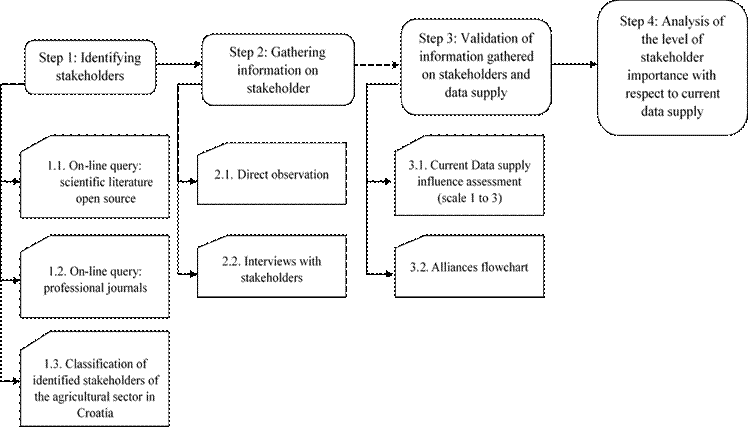
Step 1: Identifying stakeholders Open access repositories of scientific and
professional publications were chosen for the initial stakeholder identification.
Digital Academic Archives and Repositories (Dabar) and the Portal of Croatian
scientific and professional journals – Hrčak were queried for scientific
publications. Professional journals from Hrčak were searched by field, focusing on
the journals in the field of agriculture (section: “agronomy”). The complex query:
"stakeholder" OR "persons" OR "actors" OR "agriculture" OR "agriculture business" OR
"farms" OR "agriculture sector" OR "agriculture area" OR "agriculture field" AND
"open data" was used for search of the national databases Hrčak and Dabar
26. As shown in Table 1, a search based on a
complex query in the Hrčak database resulted in a total of 63 literature sources.
This query did not yield a result in the Dabar database, i.e. it resulted in 0
articles found. Therefore, a simplified query was used in Dabar with the keywords
“agriculture” and “stakeholders” and resulted in 18 literature sources. In the Hrčak
database, a search of professional journals resulted in 24 journals in the field of
agriculture. An important aspect of stakeholder analysis is based on differentiating
and classifying stakeholders according to their roles in the ecosystem. This form of
categorization enables the grouping of stakeholders according to similar
characteristics in order to identify those of strategic importance
9. Identification of relationships between all
stakeholders can help determine how stakeholders could engage in an open data
ecosystem for policy implementation, support the decision-making of sustainable
development, and manage business processes. Building on the defined basic
categorization of stakeholder groups in the agricultural sector in Croatia
26 the stakeholders identified in the queries
were classified and the new grouping was used in further data supply influence
assessment and alliance flow chart production encompassing also the data demand
side, as well as for the final prioritization (Figure 2).
Table 1. Number of articles and journals in national databases.
Figure 2. Preliminary key stakeholder groups of agricultural open data
ecosystem in Croatia used for the classification of the open access sources
query results
26
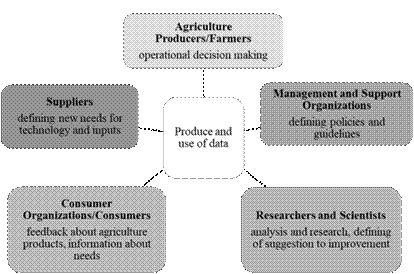
influence To identify the basic characteristics and roles of individual stakeholders
in the agricultural data ecosystem, to investigate their data requirements, as well
as the data that are the result of their work, field research was performed
including direct observation and semi-structured interviews with the following
questions (in Croatian): 1) What is your role, as a stakeholder, in the agricultural
sector? 2) Which of the 5 stakeholder groups do you have the most cooperation and
interaction with? Can you specify? 3) Do you share your management/business/product
data with any of the 5 stakeholder groups? Can you specify to whom and how? 4) From
the stakeholders identified in question 2, do you require/use any data sets and can
you specify? Would it be useful to you to get some data for your business from some
other entity you are currently not cooperating with? A breakdown of the main
stakeholder groups (Figure 2) provided the structure for interviewing the
representatives of the five stakeholder groups. In total, 24 interviews were used
for validation: 5 interviews per group of stakeholders were performed with
representatives of Agriculture producers/Farmers, the group of Suppliers and the
group of Customer Organization/Consumer; and 3 interviews per group of stakeholders
were performed with representatives of Management and Support Organizations, as well
as the Researchers/Scientists from the field of agricultural sciences. The
additional 3 representatives were interviewed from the group of other stakeholders
after the classification of the query results. Characteristics and roles of
stakeholders were additionally supplemented with 15 sets of direct observations for
the 10 of the interviewed stakeholders (3 from Management and Support Organizations,
3 from Suppliers, 2 from Researchers/Scientists, and 2 from Agriculture
producers/Farmers) and the randomly selected 5 additional representatives from each
of the stakeholder groups. All available sources, including official web sites and
on-line available documents, were reviewed for (i) the data needs, (ii) data sharing
and (iii) data sharing possibilities. Step 3: Validation of information gathered on
stakeholders and data supply and demand Qualitative data from the interviews were
used to extract the information on data needs and data sharing of the stakeholders
and stakeholder groups. Also for the data opening and sharing supply assessment and
to formulate the alliance's flowchart. The alliances flowchart contains information
on the stakeholder group relevance in the system, the data supply influence and the
alliances derived from the interviews, direct observation and the query results.
Current data supply influence assessment was estimated on a scale of 1 to 3, where
(i) 1 is considered as stakeholder data openness or sharing not known or
exceptional; (ii) 2 is considered as stakeholder data known to share, some data
known to be open; (iii) 3 is considered as stakeholder relevant open data supplier
or data sharer. The interview results and the direct observation from the previous
research step were used for this assessment according to this research group's
judgment. Scoring results were included in the alliances flowchart to distinguish
the groups assessed as relevant data suppliers, as well as to distinguish a specific
stakeholder relevant in the stakeholder group, but scoring low as data supplier.
Query results provided the number of the references in common for specific
stakeholders and stakeholder groups. This information was used as an indicator of
the stakeholder interactions and supplemented the interview and observation
information for the final alliances flowchart. The level of importance of each
stakeholder and stakeholder group used for the alliances flowchart was derived from
the frequencies of the queried references shown in Table 2. Based on the collected
data, the relations between stakeholders were constructed
27,
28,
29. Step 4: Analysis of the level of the
stakeholder importance with respect to current data supply Finally, to discover the
relevant priority groups for further focus in open data ecosystem maturation, we
have imposed the level of the stakeholder importance (derived from the number of the
query references) to the level of the stakeholder influence to the data supply
24.
RESULTS
Key stakeholders in Croatia The content of the found articles was analysed, and
special emphasis has been placed on identifying specific stakeholders operating in
or in relation to the agriculture sector. All stakeholders identified in the
articles are classified to the key stakeholder groups as shown in Table 2.
Additional group (Others) was formed containing the stakeholders that could not be
classified to the one of the initial five stakeholder groups at all, or exclusively.
Table 2. Identified stakeholders in the agricultural data ecosystem in
Croatia
| Agriculture
producers/Farmers |
owners of agricultural land30,31
milk producers32
animal breeders, cattle breeders33
meat producers34,35
vegetable producers36
forestry entrepreneurs37
fish farmers, fishermen38
producers of organic agriculture products39
flower producers40
wine and winery producers41
energy plantations42
family farms, local farms, rural holdings39,43
processors of agricultural products (milk, meat, fruits,
vegetables)44
mushroom growing45
|
| Suppliers |
manufacturers of technological solutions and mechanization in
agriculture46
hatcheries, rearing parent stock47
seed growers45,47
seedling growers48
manufacturers of plant protection products45,48
agriculture machinery market49
agricultural cooperatives49
forest owners31
landowners31
|
| Management and
Support Organization |
Ministry of Agriculture; Croatian Agency for Agriculture and
Food; Agency for Payments in Agriculture, Fisheries and
Rural Development50,51
Croatian Agricultural Advisory Service52
national training providers in the agricultural sector37
agriculture local action groups41
developed agencies in rural development and agriculture41
independent consultants in agriculture41
agriculture producers cooperatives and local
partnerships39,41
creators of agricultural programs53
issuers of certificates in agriculture54
Croatian Meteorological and Hydrological Service55
meteorological stations56
the institutional Animal Care and Ethics Committee50
State Geodetic Administration57
Croatian Veterinary Institute, veterinary institute58
Croatian Agricultural Society48,59
Croatian Society of Plant Sciences45
|
| Consumer
Organizations/Consumers |
business entities in tourism60
private accommodation, hotels61
organized gastronomic events62
local population, household39
buyers of agricultural products49
|
| Researches and
Scientists |
educational institutions34,39:
Faculty of Agriculture4549,
Faculty of Agrobiotechnical Sciences45
editorial boards of professional journals
students of agriculture and agronomy46
laboratory centres58
researchers51,
research organizations63,
multidisciplinary research teams64
forestry experts37
organizers of educational programs39
|
| Others |
owners of organic gardens and ecovillages39
hunting and hunting tourist centres65
botanical gardens66,67
school gardens48
media: agricultural portals, web pages39
employees in agriculture54
|
The group of Agricultural Producers and Farmers includes all
stakeholders who are primarily engaged in the production of any agricultural
product, processing of agricultural lands, or animal husbandry. Only those producers
who offer final agricultural product for further processing or sale are included in
this group of stakeholders. Some of the agricultural producers in the agricultural
data ecosystem are producers of milk and dairy products, meat, fruits, vegetables,
flowers, and agricultural organic products. This group includes animal breeders who
resell their breeding, but also grain producers, owners of agricultural land who
grow various crops for food purposes. Also included are sustainable users of wild
populations (e.g. fishermen and forest owners who sell their timber resources, and
mushroom pickers), fish farmers and wineries. Apart from the type of agricultural
activity they perform, Agricultural Producers and Farmers also differ in size, so in
this division in Croatia, there are family agriculture farms, as well as small,
medium and large agriculture businesses. Suppliers are all those stakeholders who
supply agricultural producers and farmers with all the necessary resources for work
such as machinery and other technological solutions, plant protection products,
re-selling seeds and seedlings, feed, flocks of animals, and more. These include
producers of agricultural machinery and technological solutions for agriculture,
hatcheries, producers of seeds and seedlings, producers of plant protection
products, owners of land and forests who rent out their land. Management and Support
Organizations include all stakeholders who provide any form of support to farmers
and enable the functioning and operations of all stakeholders in the ecosystem.
Identified stakeholders can be divided by levels. The highest level representative
is the Ministry of Agriculture and it oversees some of the lower level stakeholders.
Agricultural advisory services operate at the local level but under the authority of
the Ministry. National training providers in the agricultural sector and issuers of
certificates in agriculture who provide support to farmers in terms of education,
also operate under the authority of the Ministry. Furthermore, various agencies and
consultants with advisory capacity operate at the local and regional levels. In
addition to all the above, support in agriculture is provided by some organizations
from related other disciplines such as the State Geodetic Administration, the
Croatian Veterinary Institute, the Croatian Meteorological, and Hydrological
Service, and others. Consumer Organizations and Consumers are all stakeholders who
buy and use agricultural products, produced exclusively by agricultural producers or
farmers. These are households, private and business entities, organized events and
companies that process agricultural products, and direct consumers. The group of
Researches and Scientists includes faculties and all educational institutions in the
field of agriculture in Croatia. Educational institutions usually include research
groups and laboratories, multidisciplinary teams, project teams, and experts in the
field of agriculture. Students of agriculture are included in this group. Finally,
to the five basic stakeholder groups, the category of other stakeholders was added.
This group includes stakeholders who cannot be included in any of the previously
described groups. This group includes owners of organic gardens and ecovillages,
botanical gardens, school gardens, and hunting and hunting tourist centres.
Employees in agriculture and households that produce food for their own needs belong
to this group. In addition to them, there are also media that cover agricultural
activity and events related to it. The role of stakeholders in the agriculture data
ecosystem From the agricultural producers and farmers group, the interview was
attended by family agriculture farms and small agriculture businesses, who have less
than 10 employees (Figure 3). They unanimously agreed that their role in the
ecosystem is to produce and supply food and drink to the community. For the
producers, the most important group of stakeholders are the suppliers who supply
them with production resources. The management and support organizations are in
charge of controlling food production and enabling support for the agriculture
production. All of the agricultural producers mentioned that they have specific
certificates from the field in which they operate and that they have acquired most
of them through organized training of the Ministry of Agriculture and the Advisory
Service. Some of the producers mentioned that they cooperate with consultants, i.e.
organizations that prepare projects for them co-financed from European Union funds.
Also, all of them are in communication with the Agency for Payments in Agriculture,
Fisheries, and Rural Development, which takes care of the operational implementation
of direct support measures and rural development measures. All farmers stated that
they have no contact with researchers, scientists, and educational institutions. The
data needs of agricultural producers are diverse and depend on the type of activity
they are engaged in. For example, the vegetable producer pointed out that the most
important data for him are data about current protection products and substitute
protection products, and data about demand and prices on the market. Meat producers
stated that they need data on the quantities and prices of all food resources they
use to prepare food on their farms, followed by data on the quantities and prices of
final products on the market, data on available production incentives, and
investment opportunities. All farmers agreed, that the data they can generate is
related to the parameters of agricultural production. From the supplier group of
stakeholders, a regional representative of a company engaged in the sale of seeds,
plant protection products, and the purchase of mercantile cultivation, an employee
in an agricultural market, and a landowner who rents out his land were interviewed
(Figure 4). The regional representative of the agricultural corporation stated that
their business is based on cooperation with large and small agricultural producers
who buy from them seeds, plant protection products, and mineral fertilizers, as well
as redeem mercantile goods and lend for further production. An employee of the
agricultural shop stated that they supply the local population and households with
resources for agricultural production, and cooperate with larger farmers as agreed.
The owner of the land pointed out that he does not cultivate the land, but rents it
to an agricultural farm. The regional representative emphasized the wide range of
stakeholder partners: large and small agricultural producers, buyers of mercantile
goods, large agricultural corporations such as feed mills, competitors, and others.
An employee of an agricultural market mentioned households cultivating their gardens
and small farmers as key stakeholders. The landowner, since he rents out his land,
cooperates exclusively with the agricultural producer to whom he rents the land, the
data flow is shown in Figure 4.
Figure 3. Primary needs of data flow as recognized
in interviews with the agriculture producers.
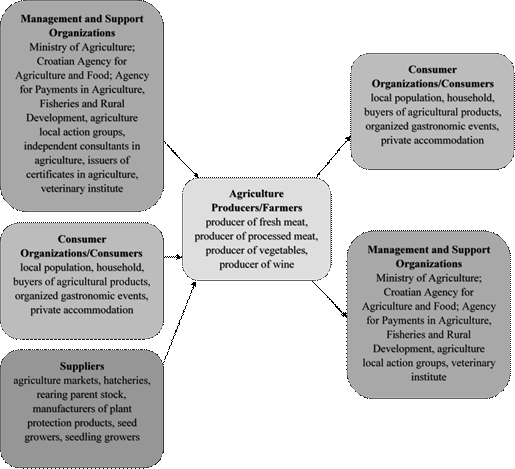
Figure 4. Primary needs of data flow as recognized in interviews with the suppliers
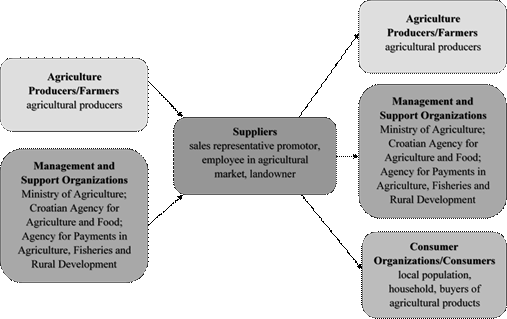
. The most important stakeholder
representative from the group of the Management and Support Organization is the
Ministry of Agriculture. The role of the Ministry is clear and refers to
administrative and other affairs in the field of agriculture. From this group, an
informal interview was conducted with an employee of the Advisory Service. They
cooperate with farmers in the implementation of various experiments, where, based on
the monitoring of agricultural production, they receive information on agricultural
practices as well as the pros and cons of agricultural production. In addition, the
role of the Advisory Service is to provide assistance to farmers through advice on
agricultural production and to apply for various measures and incentives. They
cooperate with suppliers in conducting experiments in different agriculture fields.
For example, a regional representative and a representative of the Advisory Service,
together with an agricultural producer, described their cooperation in testing new
seeds. In the group of consumer organizations, a local restaurant was selected for
the interview, which procures its food exclusively from agricultural producers and
farmers. The owner of the restaurant stated that he has big problems when procuring
fresh groceries, especially fresh meat. Mostly information about producers who offer
fresh and quality meat comes by word of mouth from acquaintances. Therefore, the
lack of data on agricultural producers and the lack a network of producers to whom
they can turn, are a problem for him in performing his business and sometimes he
cannot satisfy the entire offer in his restaurant. The scientists and researchers
group uses the data provided by different stakeholder groups, or generates the data
with their research. Importance of data provided from the private sector is crucial
in order to improve their scientific and research work, develop new projects or
suggest better solutions to certain problems. Moreover, based on the interviews,
generated data of different granularity from research is provided to the
farmers/source of the data often only upon the specific request and there is no
obligation or channel for the direct feedback to source of the data. Data
availability is also important for the group of Other stakeholders. The media inform
the wider community about the current state of the sector and individual activities,
other stakeholders and also about agricultural products. School and kinder gardens
serve to teach children from an early age about farming, especially vegetables. The
Botanical Garden serves as a centre where it is possible to be educated and
introduced of the wider community to the cultivation of plants of different species.
Alliances of the stakeholders in the agricultural data sharing ecosystem in Croatia
are shown in the Figure 5. The most striking result is the perceived lack of data
and information feedback of the Research group to the group of Agriculture producers
/ Farmers, which is in this research limited to smallholders. Additional lack of
data sharing alliances is evidenced between the groups of the Suppliers and the
Researchers. The group of Consumer Organisations and consumers does not have any
detected data sharing relations with the Management and support group using our
methods. The group of Agriculture producers / Farmers shares data with the Other
stakeholders as was recognised from the interviews and direct observations.
Stakeholder importance with respect to current data supply The stakeholder group
matrix in Figure 6 emphasizes the two stakeholder groups distinguished from the
others in the quadrant of the estimated high level of importance in the agricultural
data sharing ecosystem in Croatia and the low estimated data supply for that
ecosystem. Surprisingly, one of the groups is the Research and scientists and the
other are the Suppliers. Management and Support Organizations are recognized as the
group of the significant importance and influence in data supply in the agricultural
data sharing ecosystem in Croatia. The other stakeholder group in the same high
influence and high data supply sector are the Agriculture producers and Farmers.
Consumer Organizations/Consumers and others, as stakeholders not directly involved
in agricultural activities, have less importance and influence in the agriculture
data ecosystem.
Figure 5. Alliances of the stakeholders in the agricultural data
sharing ecosystem in Croatia
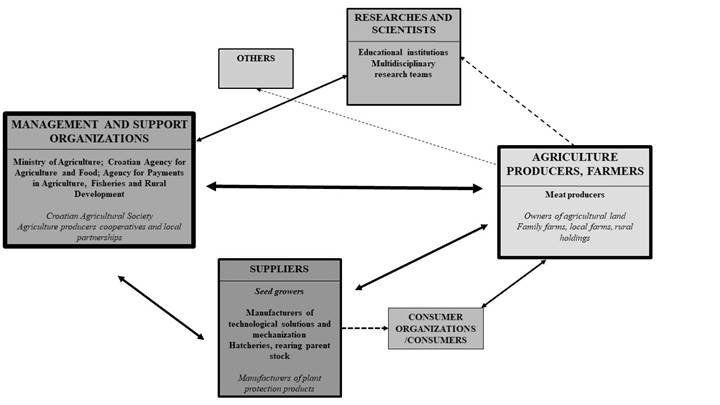
However, the low level of data from that stakeholder
was found to be concerning in the interviews where the group of Agriculture
Producers and Farmers emphasized their need to know the market prices and market
demand. The shape size represents the assessed level of importance of the
stakeholder group. The thickness of the shape border indicates relevant data
suppliers. Two-headed arrows are data sharing alliances derived from the queried
references and one-headed arrows are derived from the interviews and direct
observations. The thickness of the arrow indicates the estimated relevance of the
communication. Stakeholders with estimated high importance and low influence in data
sharing are shown in italic and the stakeholders with high importance and influence
are shown in bold font. Distinguished stakeholders, when superimposing importance in
the agricultural data sharing ecosystem in Croatia to the data sharing contribution,
were examined from each group of the
Figure 6. A stakeholder map matrix in the
agriculture data ecosystem.
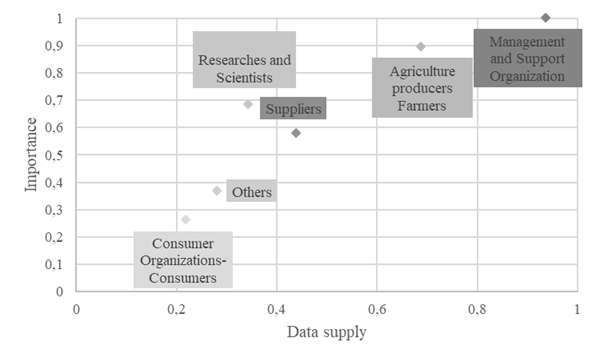
stakeholders (shown in the Figure 5). In the Agriculture
Producers/Farmers group none of the stakeholders assessed as important have an
average share in the data sharing. A high level of importance, but a low impact on
the data supply was recorded for the owners of agricultural land, meat producers and
family farms, local farms and rural holdings. Milk producers, producers of organic
agriculture products and processors of agricultural products (milk, meat, fruits,
vegetables) scored high in the group for data supply, but are assessed as less
important. In the group of Suppliers, the stakeholders that stand out with high
assessed importance and low impact to data supply are the manufacturers of plant
protection products. The seed growers are assessed as important and sharing their
data. Manufacturers of technological solutions and mechanization in agriculture,
hatcheries, seedling growers, and agricultural cooperatives scored high in the group
for data supply, but are assessed as less important. As expected, the Management and
Support Organization records the highest level of importance, but also a high level
of influence in the agriculture data ecosystem as well as data supply. The Ministry
of Agriculture scored the highest together with the Croatian Agency for Agriculture,
Croatian Agricultural Advisory Service and Food and Agency for Payments in
Agriculture, Fisheries and Rural Development. Agriculture producer's cooperatives
and local partnerships and the Croatian Agricultural Society were assessed as
important stakeholders, but sharing less data then the other stakeholders in the
group. In the group of Researches and Scientists educational institutions (i.e.
Faculty of Agriculture Faculty of Agrobiotechnical Sciences) and researchers
(research organizations and multidisciplinary research teams) are distinguished as
important and sharing more data than the other stakeholders in the group. All
stakeholders of high importance had high data influence in the Others group. In the
Consumer Organizations/Consumers all stakeholders were assessed to be equally
important and most of the data sharing in this group of stakeholders comes from the
business entities in tourism and the organized gastronomic events.
DISSCUSION AND FUTURE WORK
The analysis of key stakeholder groups in the Croatian agriculture data ecosystem
provided identification and characterisation of stakeholders and their relationships
inside the agriculture business processes, with several relevant outside connections
in the group of Management and support. Our analysis included different perspectives
in gathering the data, and only further participatory approach in stakeholder
analysis would add valuable qualitative and quantitative data and aspect
contribution if more stakeholder details are required24. This stakeholder analysis results should prove valuable in
developing collaboration, joint projects, or policies, but also in solving sectoral
business problems where the participatory approach is required24. In the further maturation of the agricultural data ecosystem
in Croatia, both for the open governmental data and the data of the public
endeavours as well as with developing the contractual sharing and the effective data
governance, the critical findings of the underdeveloped relationships, need for
better data supply should be taken into account7-14. Despite numerous initiatives
for cooperation and data sharing between stakeholders in public and private sector
at different levels, limited impact to sustainable value creation has been achieved
in industries including agriculture, and unsustainable practices persist14,68,69. Expanding on the
initiatives of open data ecosystem readiness and the ability to identify the
different ways in which stakeholders share data, build sustainable practices and
systems is crucial to the successful adoption and implementation of innovation.
Successful integration of sustainability aspects into innovation requires the
collective participation of different stakeholders, matching objectives among
stakeholders, and also their expertise as well as specialized roles for clear
transfer of added value within the ecosystem68,70,71. In order to abandon unsustainable practices and to adapt to
new digital agricultural practices it is important that the Research and scientist
as well as the Supplier group of stakeholders promote their data governance and
commit to data opening and sharing in the agriculture data sector in Croatia. It is
concerning no data flow was indicated in this research results between the Research
and Supplier groups. Additional emphasis to importance of opening up the
stakeholders mapped to the Research and scientist group in the agricultural sector
in Croatia are the results of the interviews showing limited data flow from those
stakeholders to the group of Agriculture producers and Farmers, as seen from the
perspective of the interviewed smallholders. Especially when considering
smallholders are the ones actually feeding the population72. Aside from the food production, the smallholders are the
source of a large amount of high-value data for all other stakeholders in the
agricultural data ecosystem in Croatia. In addition, their data needs, according to
the interviews, are increasing given the persistent disruptions in the agricultural
sector due to environmental, economic, and social global challenges72-74.
Market data considering the prices and the demand are the Consumer stakeholder data
important to the Agriculture Producers and Farmers group that are not enough open
and re-usable. Also, group of Suppliers emphasized data needs, as they depend on
market trends and the needs of agricultural producers, i.e. their survival depends
on performance in the agricultural market. The data of the Croatian agricultural
research sector is evidently not available to them and the contractual data sharing
from the group of Agriculture producers and Farmers is evidently limited. Management
and Support Organizations have/gather and open the most data according to the above
results, but opening of this data is limited20 and more care should be given to data governance research in this
group in order to boost the usability of this data for solving relevant sectoral
problems. The strong open data outreach responsibility of this stakeholder group is
even more pronounced by the fact that the effective cooperation required for
sustainable value creation is lacking in the complex business systems, such as
agriculture, which operate in an data ecosystem where data and information exchange
is lacking or is decentralized6.
CONCLUSIONS
The agricultural sector in general is a mine of valuable data generated in agricultural processes, however, its’ potential to generate value is not yet exploited in the ecosystem of agricultural data in Croatia. The concept of smart and precise agriculture often referred to as the digital agriculture includes collecting and systematizing data from agricultural business processes, integrating, monitoring, analysing, and interpreting data, enabling the development of sustainable practices. To enable the transition to digital agriculture and the data to generate the value, it is necessary to strategically invest into maturation of agricultural data ecosystem (interaction of people, infrastructure, and processes) in Croatia working on the underdeveloped alliances by opening data of the identified key stakeholders.
The Management and Support Organization group of stakeholders is recognised as the most important and most data influential one with the most responsibility in promoting open governmental data and open data of the public endeavours. The Agriculture producers/Farmers are the second most important and data influential stakeholder group providing data to and trough other stakeholder groups, primarily the corresponding ministry. The Suppliers group of stakeholders was characterized in this research as the one not connected well enough through the data flow with the other stakeholders. The group of Researches and Scientists in the agricultural sector in Croatia were characterized as not contributing enough to the open data ecosystem. The group of consumers is not reaching the producers with the data they require. Underdeveloped data flow relationships in the agricultural data ecosystem in Croatia could be built in a spontaneous process following the data opening of the key stakeholders and promoting data sharing initiatives of the early adopters. In that way, data opening in the agricultural data ecosystem in Croatia would be the driver of the effective cooperation creation required for sustainable value creation but also the adoption of the best management practices, sustainable solutions and digital development.
Based on the emphasized requirements from the Research group for the Supply group, and all groups for the group of Agriculture producers and Farmers, as well as recorded importance of the word-of-mouth for the market information and food product availability, it is evident that the data supply of many stakeholders is underdeveloped. Future research focusing on data demands of the stakeholders could enable faster development and maturation of the agricultural data ecosystem in Croatia.






